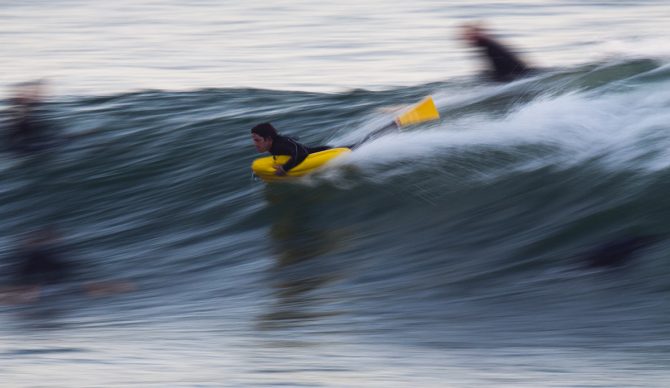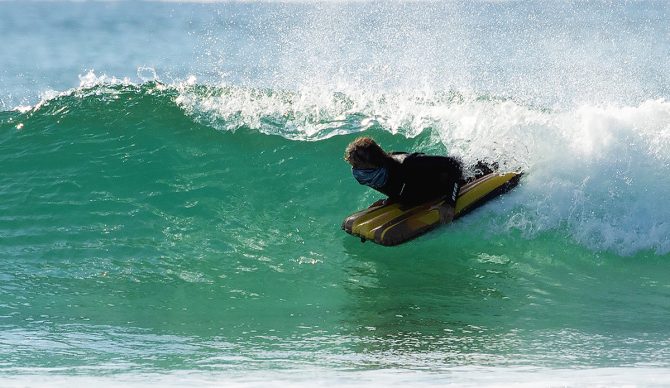
Andrew Stephen Buck, with the right grip and glide. Photo: James Fortman
Graeme Webster makes his G-Mat Custom Surfmats in the UK for mat surfers all over the globe. Calling it more like tailoring a suit, than shaping a board, he’s made mats for George Greenough, Bryce Young and Derek Hynd, and is considered the man when it comes to producing truly high-performance surf craft. I chatted with Graeme about one of the most intriguing, and evolving, fringes of surfing.
I recently saw a Bryce Young post about getting one of your custom mats. My first thought, as a layman, was that it was very different from what many people think of surfmats.
A lot of people think of the Surf Plane, which was an Aussie creation. But by the modern-day definition of a surfmat, I wouldn’t really consider the surf a plane a mat. It’s really important in terms of the heritage of the craft, but essentially, they are a floating hot water bottle. Hard, fully inflated and weighs more than a surfboard.
Talk us through Bryce’s modern version.
Well, Bryce was riding one of George Greenough’s old ones and he reached out. I’d made some for George, and Derek Hynd, who told me he hasn’t ridden a surfboard since he got on it. The modern-day surfmats are made of lightweight nylon. I get his dimensions and design the mat to fit his body shape and the waves he surfs. And they are designed to be ridden with not much air. The key is low inflation.

Derek Hynd is a disciple of the mat. Photo: Slideaholics.com
What’s the thinking behind that?
Well, how deep do you want to go? At most basic two things that go on with any surf craft are lift and drag. All the fancy stuff we do with them is basically about making use of those two principles. Essentially what’s happening is that at low inflation, the malleable bottom skin is making contact with the contours in the wave. It’s able to undulate and shape around them. So that minimizes drag which is where that speed comes from. When you see a mat ridden really well, there’s not much water coming off the back. There’s some spray which is a kind of shearing of the water, but you won’t see much displacement of water. You are riding a cushion of air, which is why it feels so unique. When riding, you push the air around to inflate different sections on either rail, or at the top or the tail.
How long have these styles of mats been around?
I started riding and making them 13 years ago, and commercially in 2013, but they didn’t exist anywhere else. Dale Solomonson who made Neumatic surfmats was one of the first to use the new materials, and he gave me loads of pointers. He pioneered the use of sealants to add textured grip to the decks of lighter-weight mats that would otherwise be un-surfable. It’s difficult because while you’ve got the rules of hydrodynamics, the mat has a pliable, changeable morphing hull and rail. So you kind of have to learn about hydrodynamics and then unlearn what you know about hydrodynamics, and then apply them again to this undulating material. I’ve done my work of learning how to make the wheel and I’m kind of at the point now where I’m trying to perfect the tire tread.
And how easy is it to get your hands on one?
I work with my business partner Tom Jennings who is a brilliant mat builder, and he does all the stock mats. I’d say he’s almost certainly building more mats than anyone in the world at the moment. But the demand for customs is strong. At one stage I had an eight-year waiting list and got that down to four. Now I run a lottery where clients can buy places. I put up 10 spots and those places go within a couple of minutes.
Is that due to a general increase in the number of mat riders?
I started a forum called matsurfers.com about seven years ago, and I figured there were probably 200 mat riders all over the world and we all knew each other. More recently videos of Andrew Buck burning off surfers at Rincon have gone viral and added interest. In one sense it’s great as we are seeing better wave riders and some great surfers pushing the designs. On the other hand, there is a purity and culture to it that can run the risk of getting a little lost.
Is there a misconception that they are easy to ride?
People are now clocking that riding the surf mats well is really, really hard. I’ve heard people describe it as wrestling or cuddling the squid. You are almost fighting this half-inflated bag of air, which is tricky. But if you’ve watched a seabird gliding across the wave, using that updraft, well that’s the feeling of riding a mat when you get it to open up, get on speed and go through the gears. It takes on the shape of the wave, and so do you. It’s a wonderful feeling.

